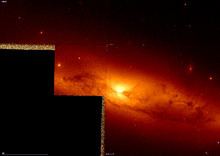Right ascension 12 21 12.891 Redshift 0.002977 Distance 54 Mly (16.5 Mpc) Magnitude 10.4 Apparent magnitude (V) 10.4 | Declination +18° 22′ 56.64″ Helio radial velocity 893 | |
 | ||
Similar NGC 4450, NGC 4448, NGC 4262, NGC 4308, NGC 4429 | ||
NGC 4293 is the New General Catalogue identifier for a lenticular galaxy in the northern constellation of Coma Berenices. It was discovered by English astronomer William Herschel on March 14, 1784, who described it as "large, extended, resolvable, 6 or 7′ long". This galaxy is positioned to the north-northwest of the star 11 Comae Berenices and is a member of the Virgo Cluster of galaxies. It is assumed to lie at the same distance as the Virgo Cluster itself: around 54 million light years away. The galaxy spans an apparent area of 5.3 × 3.1 arc minutes.
The morphological classification of NGC 4293 is (R)SB(s)0/a, with the SB0/a indicating this has just distinguishable tightly wound spiral arms with a bar structure at the nucleus. An '(s)' notation means that this galaxy does not have a ring-like structure around the nucleus. Star formation within NGC 4293 is only taking place within a confined region at the center of the galaxy. The outer stellar disk of the galaxy appears disturbed, suggesting some form of gravitational interaction.
This is a common type of active galaxy known as a LINER, which means that the optical spectrum is dominated by emission lines from gases in low energy ionization states. The activity may be the result of a supermassive black hole (SMBH) in the nucleus that is undergoing a low rate of matter accretion. The estimated mass of such an SMBH is 7007590000000000000♠5.9×107 M⊙. Radio emission from thermal activity has been detected from the proximity of this object.
